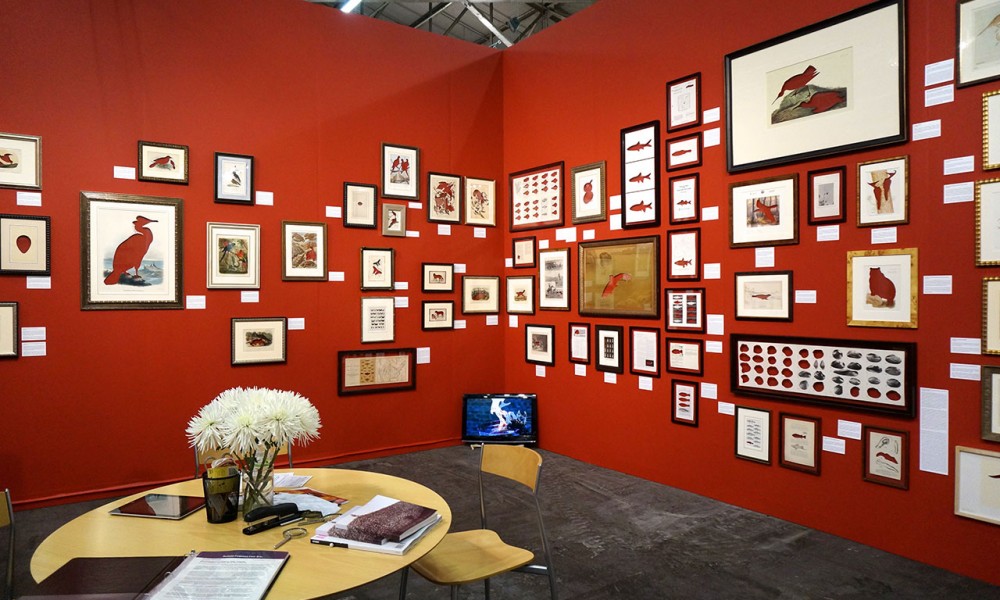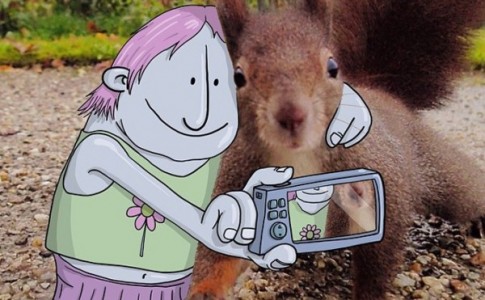The animals have gone missing from booth 844. Framed nature prints crowd the holly walls, but the auks, cougars, wolves, and woodpeckers that were once their subjects have been cut out, leaving blank spaces behind in a sort of artistic animal Rapture. Closer to the truth is that the disappearances were an act, both direct and indirect, of man.
For the series Frameworks of Absence (2006–ongoing, artist Brandon Ballengée has taken Audubon-style nature prints featuring extinct animal species, cropped out the lost creatures with scalpels and Exacto blades, and framed the stencil-like results. The extinct species remain only as blank spaces, filled by the color of the walls on which the prints hang and by the shadows cast against them. The frames, in various sizes and styles, are hung close together so that the gaps exist less between the works than within them. The installation, in the Ronald Feldman Fine Arts booth at this year’s Armory Show, is a menagerie of absence.

Installation view, Brandon Ballengée’s ‘Frameworks of Absence’ (2006–ongoing) (photo by Jillian Steinhauer/Hyperallergic)
To make the work, Ballengée collected historic prints featuring species that have been wiped out during the the mass extinction going on right now, sometimes called the sixth extinction, which is known for the at least somewhat causal role that humans play in it. The prints come from all over the world, and Ballengée specifically looked for ones printed close to the time that their featured species went extinct. To Ballengée, the “Victorian” red walls of the booth represent humanity’s destructive force and a shift from living with nature to trying to dominate it. “It’s this idea that was really born in the 19th century, that we could control nature,” he told Hyperallergic. “And as a result, we’re killing everything.”
Each work has a plaque detailing the print’s origins and describing how the excised species went extinct, a mini obituary. As I took notes so that I could accurately refer to each animal, I realized, sadly, that what anyone would really want to know about a given species — where it lived, what it looked like — was missing. It lives nowhere and its image has been destroyed. I started to worry about what would happen if, somehow, in an echo of Ballengée’s work, the remaining images of these species were lost. The thought process returns to extinction and death.

Installation view of Brandon Ballengée’s ‘The Frameworks of Absence’ (2006–ongoing) showing the urns (photo by Casey Dorobek, courtesy Ronald Feldman Fine Arts, New York)
On the installation’s grayish fourth wall are nine shelves of short black urns, 10 per row. Each is labeled “RIP [extinct species].” Inside are the ashes of not an animal but the cutouts, which Ballengée burned, from each print. A video screen on the floor at the intersection of two cardinal-colored walls shows the bright paper animals being cremated over a metal dish. The screen functions almost as a fireplace in this Victorian parlor. When the works are sold, print and urn are a package, and the buyer is encouraged to spread the ashes. “My hope is that when people have these [images] in their presence and they scatter the ashes that it’s transformative,” says Ballengée. “So they start to acknowledge the presence of this animal they never knew existed — because it doesn’t exist anymore, but hopefully it affects their behavior and makes them a little more conservation-minded and makes them care.”

Brandon Ballengée, “RIP Great Auk: After John Gould” (1873/2014), artist cut and burnt hand-colored lithograph “Pl. 55 Alca Impennis” drawn by John Gould and depicted on stone by H.C. Richter from ‘The Birds of Great Britain,’ Volume 5 published by John Gould in 1873, 13.5 x 20.5 in. The Great auk/’Pinguinus impennis’ last observed in 1855. The Great auk (‘Pinguinus impennis,’ formerly: ‘Alca Impennis’) was over-hunted for food, stuffed animal collections and sport. Once thriving in the waters of the entire North Atlantic, the last pairing of the Great auk was killed in 1844 on Eldey off the coast of Iceland. (photo by Michael Ahn)

Brandon Ballengée, “RIP Carolina Parakeet: After John James Audubon” (1940/2009), artist-cut print from ‘Audubon’s America: The Narratives and Experiences of John James Audubon,’ edited by Donald C. Peatie, published in 1940, 14 x 11 in. The Carolina parakeet (‘Conuropsis carolinensis’) was last observed (shot) in the wild in 1904, the last remaining member of this species died in captivity in 1918. This wide-spread North American species was hunted intensely as food source and because of its brightly colored feathers. Additionally much of its breeding habitats were lost to agriculture and other developments. (photo by David W. Coulter)
Brandon Ballengée’s Frameworks of Absence is on view at the Ronald Feldman Fine Arts Booth (#844) at the 2015 Armory Show (Piers 92 & 94, Hell’s Kitchen, Manhattan) through March 8.
Source: hyperallergic.com


